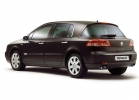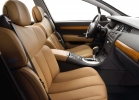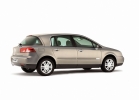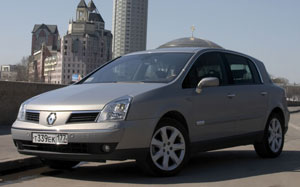Test drive by Renault Vel Satis since 2005 hatchback
VIP marginal
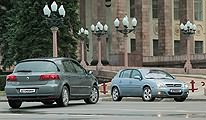 Nowadays, there are almost no pure genres, pure flowers, pure feelings. Continuous halftones, hybrids and horses. So cars are increasingly becoming the fetus not of evolution, but crossing. For example, Renault Vel Satis is not a heir to the traditional Safrane at all, but Opel Signum is not Vectra Caravan at all and not Omega. But there is already much in common in the silhouette of these new models.
Nowadays, there are almost no pure genres, pure flowers, pure feelings. Continuous halftones, hybrids and horses. So cars are increasingly becoming the fetus not of evolution, but crossing. For example, Renault Vel Satis is not a heir to the traditional Safrane at all, but Opel Signum is not Vectra Caravan at all and not Omega. But there is already much in common in the silhouette of these new models. Based on the fact that Vel satis and Signum are positioned as corporate cars and are often purchased for representative functions, we considered it reasonable to take them for the test in the most complete configuration: Opel with a 3.2 liter engine, and Renault 3.5 liters. The flagship set includes everything, everything from the machine and climate control to numerous airbags and all conceivable electronic systems. In fairness, I must say that in size, mass and power, the Frenchman is half a class larger than a German, but we calculated this error of the permissible, since there are no other applicants for such a comparison, and in the dynamics of the car are very close. A possible class advantage is redeemed by excess ten green, which will have to be given for the Europeanized Vel Satis. And another stress in this name, as in all French words, falls on the last syllable on I. Let's say correctly.
What can you expect from modern European cars with gasoline engines of more than three liters? High speed, powerful pickup, sharp acceleration. All this is obviously present on both cars. But the differences are still in abundance. Let's start with the work of the automatic transmission. The Opelian box, absolutely honestly and predictably working out each gear, is climbing with small, but tangible shocks, and besides, he almost does not want to switch down herself. Although for this there is a generally accepted manual control regime. But the renoshny automatic machine is the most adaptive of all previously met. One has only to intensively bother the gas (not even to the stop, but at least deeper than half the move), like a box, when it reaches a car of 100120 km/h, freezes in a third (out of five) gear. And so it will go until you lose momentum. And in order for the switching to pass at almost silent low speeds, it should be initially gently pressed on the trigger. And most importantly, this is quite a rather heavy and powerful Vel Satis to a smooth and unhurried way to move more to face. But I note again, Sinemovskaya agility still amazes no less, the car with a light slip leaves even with the second!
In addition to accelerated dynamics, there is also brake. It was then that the difference between the two models is much more noticeable, and not by the degree of identity, but by the sign. Opel +, and Renault. Signum, although it is impossible to call an example of instant solidification or sticking to the asphalt, but its brake pedal is easy, and the car stops where necessary. But Vel Satis has to be upset by the whole mass of its own body attached to the pedal through the right lower limb. But all the same, the car is inverted longer and indomibly seeks to demolish everything located in the way with its powerful torso. I do not exclude that the reason for this is, first of all, a much large mass, but, I think, not only. But the French machine has one significant convenience automatic brake. Suppose you parked on the hill and, for example, forgot to put the KP lever in R. The car will not move anywhere! Without your instructions, an invisible handbrake will block her. The same thing in motion. As soon as you stop how the pads grab the wheels, and release with the first touch of gas ...
Management, what do you think, which car is better to steer German or French? Correctly. Opel is almost a control standard. He has a heavy steering wheel, but without excessive effort, small rolls and absolutely adequate, calculated the trajectory, such as you personally ask him. And Renault, which moves perfectly in a straight line and gentle crooked, on steep bends quickly breaks through the front external wheel and falls out, losing intelligence and predictability. Well, do not write out snakes on it! One of the explanations of this behavior is a high body with a high center of gravity, moreover, shifted forward. And the Signum passes, at least no worse than the basic vector, and perhaps it is better due to the elongated base. But here's the bad luck, it is not so hard suspension quite clearly counts the road tubercles and holes. Therefore, I would prefer tires with a higher profile. Vel Satis is undoubtedly softer and composure more. But not to such an extent as to rock the gullible VIP passengers.
In this nomination, Opel leads as a car for an active and skill driver. Although why then, one wonders, so much space behind the front seats? Of course, in order to comfortably carry bosses, demigosses, their wives, children and mistresses. And if with comfort, then you can not drive. Providing maximum comfort with minimal variables in Renault is better than many. From the point of view of passing large, but sudden irregularities, the chances of breaking elastic elements to the stop in the French car are much higher. But in maneuverability, he is an unconditional leader of the Renome angle of rotation of the wheels noticeably smaller than Opelsky. And it is noticeable not so much in numbers as in practice, especially given the large dimensions of Vel Satis.
Ergonomics in this section conversation will be first of all about Vel Satis so distinctive and self -sufficient. Moreover, the Signum, interestingly, is almost nothing to scold. If you operate with such concepts as convenience at the wheel, etc., you can simply give the footnote see Art. About Opel Vectra. But since the body behind the middle rack is stretched to the rear passengers so valuable in the area of \u200b\u200bthe rear passengers, the main attention is precisely the second row of seats.
To begin with, we open the super-wide door and make sure that even the shoes of the 49th size should not be stuck in a barrel into a barely open gap, as is the case on most sedans. Before us is not a whole sofa, but two separate chairs with an armrest in the middle. And this is right, but only in terms of maximum comfort for two. And the third, what is extra? Yes and no. Because the armrest, after a cunning somersault along a complex kinematic trajectory for 180, turns into a jumper in the middle of the sofa. But it is not possible to place a passenger there fully and for a long time, so for a short time. But most importantly, in the back seats you can sit at least in the cylinder, and even with your legs extended.
Compared to Signum, for passengers in Vel Satis, the space is slightly smaller in length, but also plenty. And in height and width, even more. Vel satis is generally an extremely spacious car. Sitting in front, it is difficult to reach the right door, and the driver’s location above the road is not lower than Nivovsky, which in most cases allows you to look over other auto -wing. The racks that do not overlap the peripheral review contribute to a good view of the forward views, which now that the lobes have become so gentle are very rare. But behind the salon mirror, little to see the embrasure is narrow. But even the side mirrors of Renault are also not large enough to make a complete picture of what is happening from you from the rear. But the most luxurious in the French flagship is the front seats. Many competitors did not even come close to this level of comfort and design. To begin with, they are not symmetrical. The top of the backs and the headrest is cut obliquely with an increase to the outside, where the seat belt is hidden. This is very competently ensured by a tight fit of the belt to the shoulder. On our copy, the cabin of the cabin was not leather, but the suede Alkantara in combination with a composite breathing fabric. We liked it not so slippery and very respectable. But the main feature of the seats Vel Satis bending in the middle (!) Horizontally back. Therefore, using a servo drive, you can not only adjust the angle of inclination, but also the depth of the deflection. Oddly enough, sitting so comfortably so conveniently, you get tired less. Yes, and before the eyes of the driver Renault are a cool mass. This is the already well-known key-card, which can be put in a pocket and calmly get off the car it itself will close. The wipers with the rain sensor are not waving in parallel, but both to the center, like on a bus. Particularly elegant analog hours on the panel are directly from the aesthetics museum. But under them, a miracle of design, the Cabasse stereo system for six CDs, with stylish buttons. It sounds good, but deaf. But the use algorithm is intricate and illogical: the usual alternative or beauty, or functionality. At the same time, there are a lot of pockets in the cabin, a pair of drawers under the rear seats, and cold air from the climatic installation was brought to the glove compartment. In general, the luxury is in full. And no doubt, Vel Satis is on a horse.
Practicality here comes to the forefront, of course, the trunk. Renault, despite the impressive size, greatly steals the elaborate form of the stern in the interior space, leaving not too much space for lecture. In addition, the back of the rear sofa falls forward only on the pillow and does not drop to the horizontal. These are all the victims made in the sake of aerodynamics and the desire for comfort. For a very large car, this trunk is small. But the designers of Adam Opel AG tried to fame. The very spacious luggage compartment itself instantly forms a large whole volume after a light pressing of a couple of levers. And then the drop -down back pushes forward the seats and makes the floor even. Kinematically elegant, outwardly spectacular and practical. But in order to unlock the Opel fifth door, you have to press on the button either in the cabin or on the key fob. And Renault has a family shiny rhombus on the back wall, pressing the door unlocking, and then you are already pulling up, like a handle. In addition, there is no cork in Vel Satis under the gas tank. On its inside, a sealed elastic band, firmly squeezing the neck when the hatch is closed. And also the Frenchman has a lot of small amenities such as additional illumination of thresholds, trunk and ledge depths. So in practicality, the major successes of Opel are redeemed by numerous Renault pleasures.
The resume of Vel satis and signum, with external similarities, are very different in their philosophy. And if Opel is much more interesting for the driver and allows you to take much more cargo on board, then Renault offers such sophisticated amenities for all passengers that few can compete with it. And also a German car for those who think logically and do not strive for shocking. And French for more emotional people, whose desire to stand out from the crowd is supplemented by a good mat. provision.
HOW DO THEY LOOK
Nikita Rozanov
Outside: before taking this pair, I was forced to make an effort and agree that both of the hatchback cars. Although the Signum silhouette has something from the station wagon, and Vel Satis is almost a sedan in its architecture. Both cars clearly demonstrate the performance of designers of two very famous firms about mass automobile design and show the vector of development of their own style. Let's start with the characteristic, which is both in the German and the French car at the proper level. And if it were not for the small popularity of Vel Satis in our market, then the palm in this category could be given to the French. From the face of Renault, OPEL is more characteristic thanks to memorable angularity, proprietary cladding of the radiator and headlights, and, of course, unusual proportions and large glazing areas. Opel does not lag behind, his face is no less characteristic due to the style of the front light -developed lifting. This is the fashion and confirmation of kinship with the GM brand, where from now on the latest look of the flagship of the entire Cadillac department, for example, the CTS sedan, for the last models. From the point of view of fashion, both cars formally protrude on equal terms, since they demonstrate a commitment to the technological style of techno. True, because of this, both the architecture of the main volume of the Renault body, and its plastic is lost in visual dynamics, but everything looks very whole. Opel demonstrates in German verified and geometrically clear lines: absolutely circular arches of the wheels and the wedge of the windowsill, drawn by strict straight. Vel Satis is more free from fashion and builds its architecture a little more lively plastic and complex curves. The recognition of the back of each car is reinforced by its hint: Opel is brutally solid and straightforward, and Vel Satis flaunts the triangle of the bar of the rack with, which is still a very characteristic sign of the latter Renault.
 Inside: the nature of the plasticity and the style of interiors of both cars is extremely close to the external design. The plastic panel of the Vel Satis instrument panels is a more hooliganist and knocks down the neurizontal lines of the central console with a serious mood, and indeed a more free handling of the laws of the artistic composition. The Opel interior style is a militant techno, strict and straightforward, and even a little conservative. A very solid style saves the case, in which, until recently, Grundig TVs trimmed under a tree shone. The composition of the instrument panel is classically t-shaped, which is emphasized by an encircling salon with a lining under not understand what. The fact that Opel is for some part of the American, you see, noticing on the formed panel of the ceiling there are many pockets and scoundrels and two cup holders between two uncompromising (by the number of passengers) in places of the rear passengers. Vel Satis is a real Frenchman, and therefore individual and playful. Legal boxes under the seats and curtains on the side windows are pushing to ride at night to the Pigal dance at night ... The steering wheel is also made in accordance with the occupied position: they are solid four -spokes and proudly carry the silver emblems of their companies in the geometric center.
Inside: the nature of the plasticity and the style of interiors of both cars is extremely close to the external design. The plastic panel of the Vel Satis instrument panels is a more hooliganist and knocks down the neurizontal lines of the central console with a serious mood, and indeed a more free handling of the laws of the artistic composition. The Opel interior style is a militant techno, strict and straightforward, and even a little conservative. A very solid style saves the case, in which, until recently, Grundig TVs trimmed under a tree shone. The composition of the instrument panel is classically t-shaped, which is emphasized by an encircling salon with a lining under not understand what. The fact that Opel is for some part of the American, you see, noticing on the formed panel of the ceiling there are many pockets and scoundrels and two cup holders between two uncompromising (by the number of passengers) in places of the rear passengers. Vel Satis is a real Frenchman, and therefore individual and playful. Legal boxes under the seats and curtains on the side windows are pushing to ride at night to the Pigal dance at night ... The steering wheel is also made in accordance with the occupied position: they are solid four -spokes and proudly carry the silver emblems of their companies in the geometric center. Summary: I think that there are no winners or defeated in our test: Fifty Fifi. Signum without Vel Satis may seem unnecessarily linear, flat, even boring. In turn, Vel satis without Signum is not a car in the traditional sense, but a primary joke.
Text Vladimir Smirnov photo Alexander Nozdrin
Source: Cars
Video test drives Renault Vel Satis since 2005
Renault Vel Satis Crash Video since 2005
Test drive by Renault Vel Satis since 2005
Renault Vel Satis Crash Test since 2005
Krassh Test: Detailed Information34%
Driver and passengers
2%
Pedestrians

